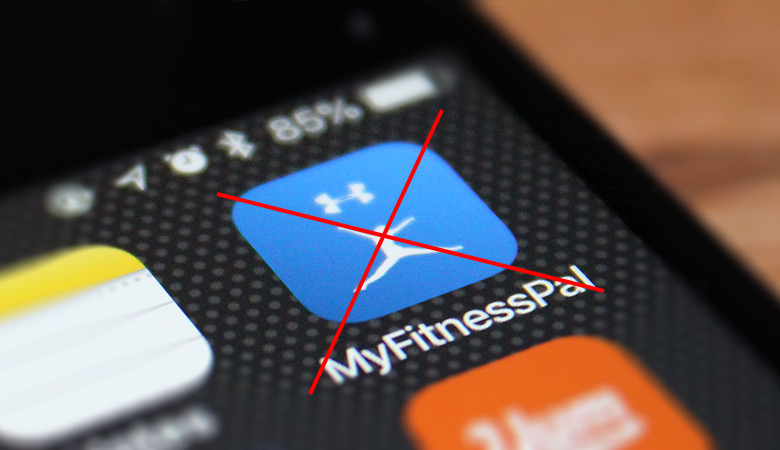
I am and I have always been a huge fan of counting calories and macros (mainly protein), in order to lose fat. I do it myself (mostly) and I do it for my clients initially as I believe counting can truly help people become aware of how much they’re actually eating.
But, I also realize that not everyone want to count their calories and macros. So, don’t listen to people who say that you can’t get lean and ripped without counting, because you absolutely can!
In this post I’ll guide you through the 8 strategies and 3 tricks that I’ve tried myself with good results, and that I’ve also guided some of my clients who don’t want to count their calories and macros with.
So, let’s go!
Table of Contents
The 8 Strategies For Losing Fat Without Counting Calories And Macros
What I’m about to say is something that I’m sure you’ve heard often, in fact it’ll probably make you blue in the face by now, but it’s very important so it’s worth repeating:
In order to lose fat you must control your caloric intake. This is the main reason why counting your calories (and macros) is so powerful. Because by counting you ensure control that you maintain a caloric deficit.
But, is it possible to ensure control over your caloric intake without counting? How can you make sure that you’re not eating too much and that you’re on your way to a ripped and lean physique without having to depend on an app?
Well, you must rely on certain strategies that will help keep your caloric intake under control without you having to count them. So without further ado, let’s look at those strategies now:
Strategy #1 – Eat Protein and Veggies in Every Meal
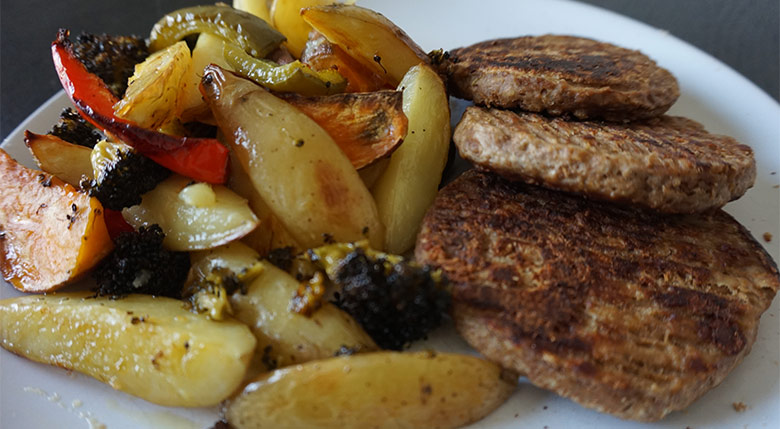
A high protein and veggie intake is definitely the best thing you can do to reduce the amount of calories you consume throughout your days. The reason for this is that these types of food are highly satiating.
The Power of Protein
Protein helps with satiety and fat loss in multiple ways. First of all, research has shown that sensory, cognitive, post-ingestive and post-absorptive signals (all stuff that’s going on when you eat) of a meal high in protein determine the feeling of satiation and satiety.
Secondly, and the thing that makes protein such a powerful fat loss macronutrient, is that only 67-80% of the energy (calories) contained in protein will actually be used as energy in the body. In other words, studies has shown that 20-33% of calories from ingested protein were lost, depending on the nutritional state of the subject – 20% when fed and 33% when glycogen depleted.
Why this massive loss in calories? Well, in short, protein contains nitrogen which needs to be removed before amino acids can be put to use. Once amino acids are freed from the nitrogen, they’re used for energy-demanding processes such as protein synthesis and de novo gluconeogenesis.
So, if you eat let’s say 300 kcal worth of protein in a meal, not only will you feel very satiated for longer after your meal, but your body will also only be able to use 200-240 of those initial 300 kcal as energy.
The Power of Vegetables
Vegetables take up a ton of space and contains very few calories. This will make your stomach fuller on fewer calories and help you feel more satiated.
Here’s a great chart of the fullness factor for some common foods that I found in this great post:
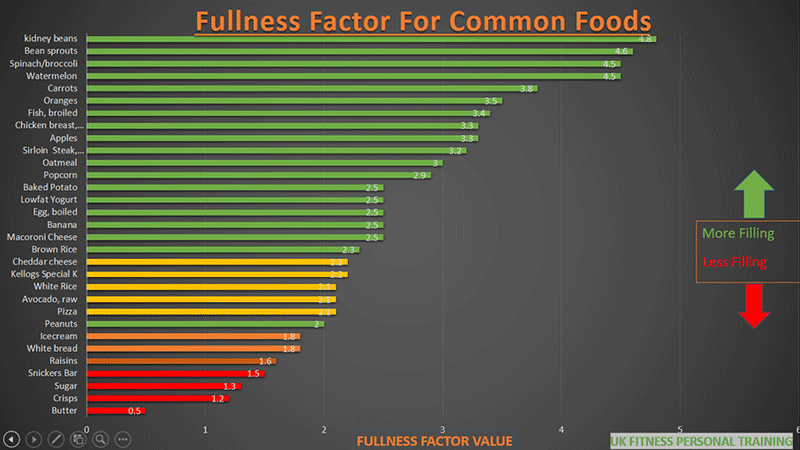
If you choose to eat more food from the most filling sources the easier you will have to stay in a calorie deficit without having to count your intake. As you can see in the chart, both protein sources and veggies are at the top.
Strategy #2 – Eat The Same Foods on Most of Your Days
I know that this might sound a bit dull to hear, but it’s not as bad as you think. Most people that I’ve seen get very lean eat more or less the same foods every day for prolonged periods of time.
The reason we can get away with eating the same food for long is because we enjoy the food we eat, rarely get bored of it, and we don’t spend a lot of time cooking, eating and cleaning.
I recommend that people start dieting in this way, even if they count their calories and macros. This is because they will learn to fit their diet into their lifestyle which is very important.
To make this work, find a few protein sources that you enjoy and also a few starchy carb sources and make these the base of your diet. If you want some inspiration for tasty and fullfilling meals that you can base your diet around, read this post next.
Strategy #3 – Buy/Cook Only as Much Food as You Intend to Eat
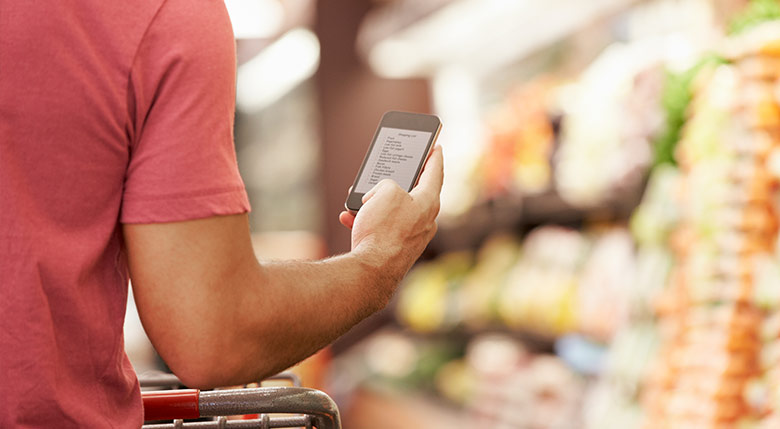
This is an important strategy, especially if you tend to constanty graze on foods when you feel a bit hungry. In fact, here’s a quote that I like:
“It’s easier to change your environment to work for you, than it is to use willpower. “ – dr Brian Wansink
How much and what we choose to eat are highly influenced by our environment. This is the reason why overweight and obesity rates are climbing so rapidly in the western civilization. We are surrounded by tasty and unsatiating foods that are very easy to access and consume.
For instance, in this study by Brian Wansink, they discovered that people always eat more of any food if they have a larger quantity. The best example is the popcorn trial they conducted in the study mentioned. In a 2 x 2 between-subjects design, 158 moviegoers in Philadelphia (57.6% male; 28.7 years) were randomly given a medium (120 g) or a large (240 g) container of free popcorn that was either fresh or stale (14 days old). Following the movie, consumption measures were taken, along with measures of perceived taste.
The results?
Moviegoers who were given fresh popcorn ate 45.3% more popcorn when it was given to them in large containers. This container-size influence is so powerful that even when the popcorn was disliked, people still ate 33.6% more popcorn when eating from a large container than from a medium-size container.
So, what can we learn from this?
Well the first thing would be to not cook more food than you intend to eat. Research clearly shows that if there’s more food available, you will eat more than you actually need.
Secondly, don’t keep snack inside the house. If you’ve stocked up on a lot of food at home, especially food that is easy to consume in a rush, even “healthy” foods such as nuts and dried fruits, the risk of you overeating is a lot higher.
You might think that it’s okay to eat a handful of nuts a couple of times per day. But, two handfuls of nuts is likely to be around 40-60 grams, which is about 250-400 calories extra per day. This might be enough to offset your entire calorie deficit through the day.
I’ve found that people who successfully get lean without counting their calories set their preferred meal frequency and then avoid snacking in-between their meals.
Strategy #4 – Guesstimate Quantities
As you create your meals you’ll need to guesstimate how much protein, carbs and fats you’re having. This will be easy as you’ll be eating the same foods on a daily basis.
Now, before you master this skill, here’s a quick guide to get you going taht I learned from Radu Antoniu’s book Cutting without Counting:
Protein sources:
- Cooked meat (beef, pork, chicken, fish, etc.) the size of your palm = 20-25 grams of protein (fat content will vary depending on the type of meat)
- One egg = 6 grams of protein, 6 grams of fat
- One egg white = 4 grams of protein
- One tablespoon of low-fat cheese (as much cheese as you can take witha spoon) = 5 grams of protein, 1 gram of fat
- One tablespoon of boiled or canned beans, drained = 1g protein, 3gcarbs
- One block of tofu the size of your fist = 20g protein, 5g carbs, 8g fat
Carb sources:
- One piece of fruit (or one cup of small fruits) = 20 grams of carbs
- Potato the size of a closed fist = 40 grams of carbs
- One cup of cooked rice = 50 grams of carbs
- One medium size slice of bread = 15-20 grams of carbs
- Two cups of veggies = 25 grams of carb
Fat sources:
- One tablespoon of oil = 10-15 grams of fats
- One tablespoon of butter = 5-10 grams of fat
What’s most important when it comes to getting a ripped physique is that you eat enough protein per day. Aim for around 1g per lb (2g per kg) of body weight per day. So, if you weigh 170 lbs you should eat 170 grams of protein per day, which could be 4 palms of cooked meat, 4 eggs, 5 tablespoons of cheese and 20 tablespoons of boiled beans spread out over your preferred meal frequency.
Make sure you eat small amounts of starchy carbs (potatoes, bread, rice, corn) in every meal. Your fat intake will take care of itself from the eggs and cheese and also from the oil or butter you cook with. Finally, make sure you eat a lot of veggies in each meal as discussed above.
Strategy #5 – Use Intermittent Fasting
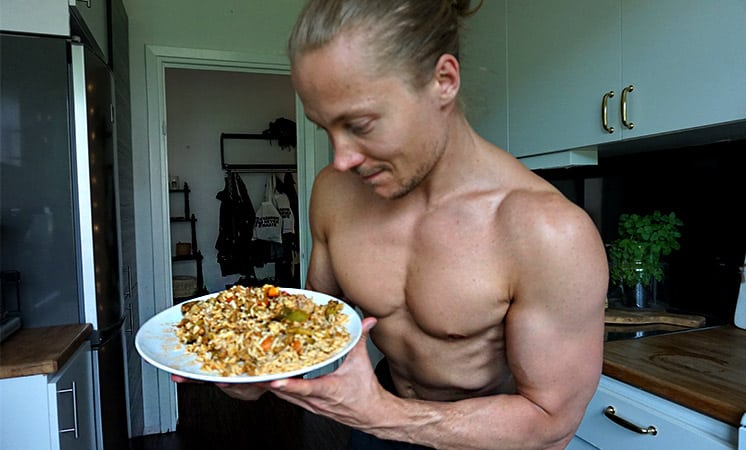
Okay, so far we’ve covered the food choices, let’s now look at the structure of your diet and how manipulating it can significantly improve your dieting adherence and make it very easy for you to avoid overeating.
First of all I want to mention that if you count your calories and macros then meal frequency is irrelevant. Whether you eat 2 meals per day or 6 meals per day will have no measurable effect on your fat loss results. The only thing that matters is the amount of calories and macros you consume over your days and weeks.
However, if you’re not counting your calories and macros then the meal frequency you choose can have a huge impact on your results. This is because the meal frequency you choose can heavily impact your feelings of satiety and also your enjoyment to the diet.
I’ve found that the majority of people, myself included, do best on a lower meal frequency schedule with bigger meals and often skipping breakfast, ala intermittent fasting.
The reason why intermittnet fasting work so well is because most people never truly feel satisfied eating multiple tiny meals per day and they also lose a lot of time cooking, eating and cleaning by doing so. That’s why I believe a better strategy is to eat only 2 or 3 big meals a day using an intermittent fasting schedule. This way you will achieve a negative energy balance but you can still eat big meals that leave you satisfied. You will experience much less psychological pressure this way.
I’m sure you’ve heard about intermittent fasting. It’s a meal pattern where you alterante between periods of being fasted and non-fasted. There are several popular types of fasting such as Leangains, The Warrior Diet, and Eat Stop Eat but in this article I refer to a simple form of daily fasting that I call Flexible Fasting, where you’re just simply skipping breakfast.
Here’s what the diet schedule could look like:
2 Meal IF Schedule:
- Fast for 5-7 hours after waking up
- Meal 1 (1-3 PM):
- 30-40% of daily calories
- High protein, medium fat and low-medium carbs
- Meal 2 (6-8 PM) :
- 60-70% of daily calories
- Medium protein, medium fat and high carbs
3 Meal IF Schedule:
- Fast for 5-7 hours after waking up
- Meal 1 (12-2 PM):
- 20-30% of daily calories
- Medium protein, medium fat and low carbs
- Meal 2 (4-6 PM):
- 40-50% of daily calories
- High protein, medium fat and medium-high carbs
- Meal 3 (8-9 PM):
- 20-30% of daily calories
- Low protein, medium fat and high carbs
Training should be done between the meals or right before the first meal.
Most often I recommend making the first meal the smallest one. I’ve found this to be the most enjoyable way to eat both for myself and for my clients.
Now, if you’re not familiar with intermittent fasting and why I recommend it, let me explain why this eating pattern is so powerful for hunger control and enjoyment to the diet.
Why I recommend skipping breakfast
The reason why I recommend that you give up breakfast is because many of us, myself included, aren’t that hungry in the morning. Strangely enough, many of us actually get hungrier a few hours after eating breakfast than if we just skipped it.
How many times have you experienced the feeling of hunger while not being able to eat at that point, just to find out a couple of hours later that your hunger is gone? This phenomenon happens because during the period of fasting, your sympathetic nervous system activity increases, and with that, various hormones get released that dampen your hunger. This happens because your mind and body wants you to start move around and seek food, which increases your chance of survival. So, by skipping breakfast, you take advantage of this phenomenon.
Another reason for skipping breakfast is that you already get the hours of fasting from your sleep with you, that way, you can easily fast for a longer time to allow for more food later in the day.
Why I recommend eating more during the second part of the day
I recommend that you eat most of your food during the afternoon and evenings, as this leads to incredible comfort and satiety. Most people are genetically programed to eat more in the evening. Some researchers speculate that this was how we as species were developed through evolution; we hunted and gathered food during the morning and day hours and could then eat and relax during the evening. If you think about it, this fits perfectly into our daily society as well. In the morning, we go to school or work and are generally busy with the important tasks we have scheduled, and we’re only able to cook and prepare food in the evening.
Furthermore, almost every social event and gathering, such as parties, hanging out with friends, going to see a movie or having a family dinner happens at night. That’s why it makes a lot of sense to save most of your precious calories for the evening meals as well.
Another big reason why I recommend eating bigger at night is that most people find it very unpleasant to go to bed hungry. Personally, I often experience troubles falling asleep and it even happens that I wake up during the night feeling hungry if I didn’t eat the night before.
Benefits on adherence and wellbeing with intermittent fasting
If you want to learn more about intermittent fasting and its benefits when it comes to getting lean, you can read about it in my complete intermittent fasting guide here. But, here’s a quick summary on why I think intermittent fasting works so well when it comes to cutting body fat:
- Better hunger control because of the period of fasting.
- Harder to eat too much during a short eating window.
- Larger meals = more satiating meals.
- Less time spent cooking, cleaning and eating food.
- Saves up a lot of calories for the evening, making eating at social events easier.
- Removes the need of “cheat meals.”
Strategy #6 – Use Smaller Plates
This is such a simple, yet great strategy for increasing your satiety. Researcher and author Brian Wansink performed a study where he randomly assigned partygoers to receive either a smaller (17 oz.) or larger (34 oz.) bowl, and either a smaller (2 oz.) or larger (3 oz.) ice cream scooper. Participants then filled out a survey while researchers weighed how much ice cream participants put in their bowls. By the end of the party, all but three participants had finished their ice cream.
They found that the participants that ate from larger bowls ate 30% more ice cream than those who ate from smaller bowls. Also, the participants who ate using larger serving spoons picked and ate 14% more ice cream than those using smaller spoons, regardless of their bowl size. So all in all, people who had both a larger bowl and used a larger spoon ate 50% more ice cream than people with smaller bowl and spoon pairs.
So, not only does the bowl size and the size of the spoon we pick our food with influence how much we eat, the feeling of satiety is also influenced by how many calories we think we’ve eaten. In one study two groups of people were served the same 300 kcal meal but one group was told it had 150 kcal and the other was told it had 450 kcal. The group of people who thought they ate 450 kcal reported feeling a lot fuller than the 150 kcal group, when in fact they’ve eaten just as much.
These findings truly fascinates me, so much that I had to try it out myself. For a week I changed out my larger plates to eat from smaller plates instead, here’s the difference between the plate I used to eat from (on the right) and the plate I switched to (on the left):
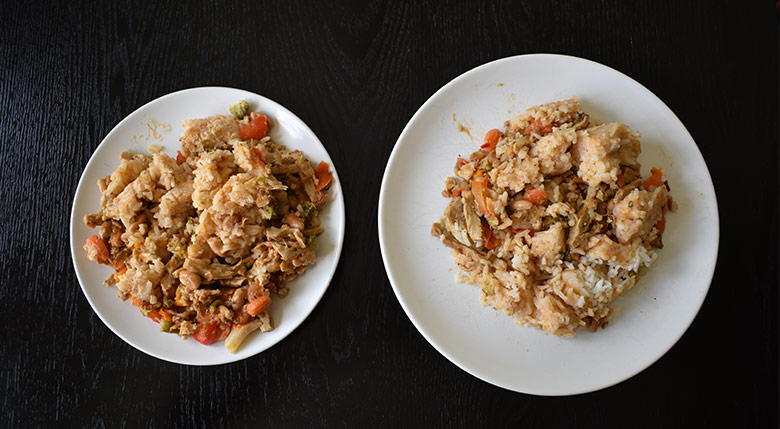
It’s the same amount of food on both of these plates, but it sure feels like I eat a lot more and also get more full when I use the smaller plate instead of the big one. Fascinating to say the least.
Strategy #7 – Eat Slow
We all have heard that eating slowly reduces the amount of food we eat and increase out feelings of satiety.
The problem is that most of us don’t eat slowly because it’s no fun to consciously restrain outselves from eating big bites. There’s one simple solution for this though, which is to use smaller forks or spoons, or even using chopsticks. This way you will be forced to eat slower and you’ll feel more satisfied at the end of the meal.
You can also learn to chew your food more. Chewing your food at least 20 times before swallowing has be shown to improve satiety and also significantly improve digestion.
Strategy #8 – Trust Your Hunger
My last strategy for successfuly losing body fat without counting your calories is to learn to trust your hunger signals. Fat loss is about being in a prolonged calorie deficit, and guess what, a calorie deficit will always lead to periods where you feel a bit of hunger.
My challenge to you is to embrace the hunger, know that your hunger is actually a good sign! It’s a sign that you’re losing body fat. But be smart about it, and set up your diet in a way that causes you to experience hunger during the right moments.
This is why I love intermittent fasting. I know that the hunger I feel during those 5-7 hours in the morning and day when I’m fasting is melting my fat away. I then know that I have the afternoon and evening to eat big and satiating meals that fulfill me during the times that I need it the most. The trick is to not overeat during the feeding hours, which is easily done by following all the strategies from this list.
Additional Tips For Making Non-Counting Easier
Okay so there we go, if you follow the 8 strategies listed above you will be able to lose body fat fairly easily without having to count your calories and macros.
Now I want to provide you with some additional tips for making your non-counting fat loss journey even easier, so here they are:
Tip #1 – Eat a HUGE Sallad Every Day
This is a great tip that I got from Matt Ogus. Matt’s famous for always eating HUGE sallads, These sallads may contain around 100-200 kcal but they’re big as hell and they’re so filling that he can eat far less from other foods and still feel very satiated and satisfied.
Tip #2 – Don’t Drink Calories
Drinking your calories is the least filling way to consume calories. It’s been shown that drinking 100 kcal provides nearly no satiating effect at all. Obviously this is very bad if your goal is to lose body fat, especially if you’re not counting your calories.
Again, the more you can eat from highly filling sources, the easier time you will have staying in a calorie deficit.
Tip #3 – Avoid Eating Highly Refined Carbs
Just as drinking calories, highly refined carbs also provide very little satiety and fullness. Highly refined carbs also spikes insulin giving you that rush of energy followed by lethargic feelings shortly thereafter.
Aim for starchy carbs as these take longer for your body to break down into glucose, which will provide you with more sustained energy. Sustained energy equals better well-being and promotes activity, which is great for fat loss.
Advantages And Disadvantages of Not Counting Calories And Macros
Before finishing up this article I quickly want to shine some light on the advantages and disadvantages of not counting your calories and macros.
Advantages of Not Counting Calories And Macros
Time Saving
One big advantage that comes with not counting is that you don’t have to spend a lot of time weighing food and adding it into your app (or however you choose to track your food). This is perfect for busy times.
Keeps Your Mind Off of Food
If you go with a non-counting strategy you’ll be thinking less about food than what you would if you were counting. When counting it’s much easier to get into the habit of thinking things like; “what will I eat next?” and “let me check how many calories I have left for the day, maybe I can fit this or that in”
Disadvantages of Not Counting Calories And Macros
Not Flexible
This is perhaps the biggest reason why I personally like to actually count my calories and macros. When I’m counting I can really eat anything that I want as long as it fits my calories and macros. If I’m not counting, then I have to avoid high calorie foods most of the time and focus more on moderation and sticking to the same foods.
Quaranteed Results
I’ve found that by counting my calories and macros I see much more predictable results. I set the calorie deficit, maybe adjust it a little if I don’t drop what I theoretically thought I would, and then it’s more or less a straight path to rippedville.
What’s your thought on counting vs not counting your calories and macros? Do you prefer counting or not? Let me know down in the comments!

THANKS for all the info! I knew many of the things written here and I do follow them. I “discovered” the huge salad thing myself, haha, and it is super useful when travelling for work when I cannot pay so much attention to what and how much I eat, and stress might make me hungry, with a huge salad I make sure I got vitamins, something in my stomach and I can then choose some lean protein to complete my meal. But thanks for all the tips and reminders.
No problems, just glad to be able to help! Yea the sallad works amazingly well, especially as you say, when you feel stressed and hungry.
Hi Niklas!
Newbie reader here. Big fan of your content. I’ve been trying to send you an email asking a few questions regarding your guide, but it keeps bouncing back. Should I use this platform instead or should I try emailing again?
Thanks for your help!
Hey Gabriela!
Glad you like the content 🙂 Hm that’s weird, did you email this address: [email protected] ?
It’s working for me when I’m emailing myself from one of my other emails. Try again, if it’s not working you can write here or DM my instagram: https://www.instagram.com/niklaslampi/